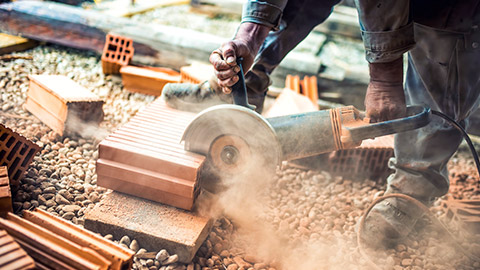We are now going to look at hazardous substances and materials. Hazardous substances and materials are any chemical, mixture or material that can pose a significant risk to a person’s health and/or safety if not managed correctly. Hazardous substances can have health hazards (that is, they can cause illness) or physical hazards (that is, they can cause injury). They can also cause both health and physical injuries.
In your workplace or onsite, there are certain signs that are erected to inform anyone onsite or bypassers there are hazardous substances and materials present.
The following signs are reflective of common examples that you may see that represent hazardous substances and materials, Take some time and flick through each image to familiarise yourself with the signs.
Workplaces have a number of responsibilities in relation to controlling the risks associated with hazardous substances and materials. There are other parties that have responsibilities too. These may include:
- manufactureres
- suppliers
- importers
- transporters
The way that the hazards associated with chemicals and other potentially harmful materials are managed and controlled are the same as any other hazard. They need to be identified, assessed and controlled.
You will find more information about managing the risks associated with hazardous substances and materials at Safe Work Australia: Chemicals

One hazardous material that is particularly relevant to building and construction is asbestos. Asbestos fibres are very fine fibres that, when inhaled, can cause severe, life-limiting lung diseases. Asbestos is now banned in Australia and has been since December 2003. However, it was once used in almost 3000 products, many of which related to the building and construction industry from the 1940s to-1980s.
The following list provides you with some of the products that asbestos was commonly found in.1
- Friable asbestos- this is dry and could be reduced to powder with hand pressure after work processes.
- Non-friable asbestos- the materials may be dry; however, they will not crumble, but they may have been mixed with cement or other bonding materials.
- Backing of vinyl sheet floor covering
- Carpet underlay
- Cement flooring
- Compressed asbestos sheet
- Flues to fireplaces
- Insulation below the wood heater
- Kitchen splashback
- Loose-fill insulation in the roof cavity
- “Tilux” marble finish wall panel
- Wall sheeting – internal
- Backing for electrical meter boards
- Downpipes
- Garage
- Gutters
- Insulation for hot water pipes and tank
- Internal and external ventilators
- Ridge capping
- Sheds and external toilets
- Wall sheeting – external
Workplaces now have legislated responsibilities around managing the risks associated with asbestos, including:
- maintaining an asbestos register
- assessing the risk of exposure to asbestos
- eliminating the risks associated with asbestos
- ongoing review of the asbestos control measures to ensure they are effective.
The following 7 steps outline what you should do if you suspect materials that contain asbestos.
- Do not disturb the material.
- Follow your workplace’s policies and procedures.
- Report your suspicion to the site supervisor immediately so that specialised testing/removal can be organised.
- Isolate the area.
- Label materials as asbestos containing (or place label/sign near the materials).
- Put up barriers/barricades to protect the materials and to protect others from working in the area.
- Don’t handle or move the materials.
When asbestos is present in an area, some tools and equipment are not safe to be used in that area as there is a risk that they could disturb it. For example, high-pressure water sprays/ cleaners, jets, power tools, compressed air, abrasive blasting and household vacuum cleaners.
It is important to be aware of these restrictions, follow your workplace requirement, and maintain situational awareness around signs, barriers and warning tape.

Silica dust is generated during the cutting, grinding and polishing of stone and other products that contain silica, such as fibre cement sheeting. Tiny particles can be inhaled and can cause irreversible, life-limiting lung damage. Some call silica dust the new asbestos.
While awareness around asbestos is high, awareness around silica dust is still emerging.

